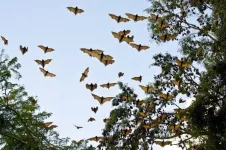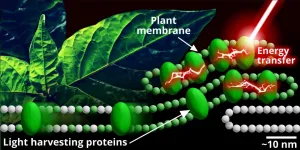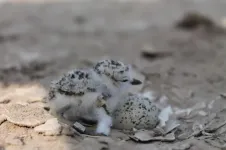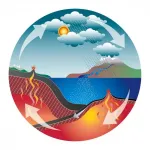Marjoram supports health and weight gain in carps, say biologist from RUDN University
2021-03-11
(Press-News.org) Biologists from RUDN University suggested adding a marjoram-based supplement to the diet of common carp to support the growth of the fish and improve their resistance to bacterial infections. The results of the study were published in the Fish & Shellfish Immunology journal.
Cyprinus carpio is a type of large omnivore fish that grows 35-40 cm long in three to five years. 4 mln tons of carps were bred in aquacultural farms in 2010. Such farms protect natural populations of Cyprinus carpio while at the same time satisfying the market demand. However, as farmers strive for higher productivity, aquacultural farms become more and more crowded which leads to the lack of nutrients and harms the health of the fish. A team of veterinarians from RUDN University tested the effect of a dietary supplement based on marjoram (a herb from the genus Origanum) on farm-bred carps.
"The profitability of a fish farm directly correlates with the stability and efficiency of production which is based on the health of the fish. Fish under stress are more susceptible to disease, and after being treated with antibiotics for some time they develop resistance. Moreover, antibiotics are harmful to the environment and can potentially affect the health of consumers. The best way to combat diseases is via dietary supplements that suppress stress, improve the health of the fish, and support their immunity," said Morteza Yousefi, PhD, an assistant professor at the Department of Veterinary Medicine, RUDN University.
The team divided 360 fish into four groups and fed them dietary supplements with different concentrations of marjoram for eight weeks. A control group did not receive marjoram at all, while the other three got 100, 200, and 400 mg per 1 kg of body mass, respectively. After 60 days of the diet, 30 fish from each group were injected with the bacterial culture of Aeromonas hydrophila, one of the most dangerous pathogens for carps that breaks down hemoglobin, enters the organs of a fish body, and then begins to produce aerolysin, a toxic substance that causes cell death and tissue damage. Then, the team spent 10 days monitoring the survival rates of the infected fish.
Only 50% of the fish from the control group successfully overcame the infection, while the share of survivors among the fish that received marjoram was 80%. The group that received 200 mg of the supplement demonstrated the most prominent positive effect including a 1.5 times increase in erythrocyte count and hemoglobin, immunoglobulins, lysozyme, and alkaline phosphatase levels. This group also showed the lowest feed conversion rate, i.e. it required less food to gain 1 kg of weight (1.32 mg against 1.62 mg in the control group). According to the veterinarians, it indicated higher immune activity and better barrier functions of the mucus in the fish that received the marjoram supplement.
"The fish that received 200 mg/kg of marjoram demonstrated the highest survival rate. Our study confirms that marjoram extract is an effective dietary supplement for the common carp: it stimulates growth, the production of antioxidants, and the work of the immune system. All these factors helped the fish infected with Aeromonas hydrophila combat the disease," added Morteza Yousefi from RUDN University.
INFORMATION:
[Attachments] See images for this press release:

ELSE PRESS RELEASES FROM THIS DATE:
2021-03-11
CABI scientist Dr Arne Witt has shared his expertise on invasive alien plant species as part of a new paper which argues that healthy ecosystems are vital in reducing the risk of future pandemics - such as coronaviruses (including COVID-19) - that threaten human health.
The paper - 'Land use-induced spillover: priority actions for protected and conserved area managers' - is published as part of a special issue by the journal PARKS entitled 'COVID-19 and Protected Areas: Essential Reading for a World Haunted by a Pandemic.'
Lead author Dr Jamie K. Reaser - along with a team of researchers from institutions including the African Wildlife Foundation, the University ...
2021-03-11
Exposure to SARS-Co-V2, the virus that causes COVID-19, can put otherwise healthy children and adolescents at risk for Multisystem Inflammatory Syndrome in Children (MIS-C), a rare but possibly life-threatening pediatric condition that can cause severe inflammation in organs like the heart, brain, lungs, kidneys and gastrointestinal system.
Diagnosing and treating MIS-C -- which has affected 2,600 children since May 2020 and is known to occur in children who have tested positive for SARS-Co-V2 or been exposed to someone with COVID-19 -- is difficult because respiratory and gastrointestinal symptoms can be similar to severe COVID-19. Other features of MIS-C are very similar to Kawasaki disease, which causes inflammation ...
2021-03-11
Rare earth elements are the gold of the 21st century: rare and highly prized all over the world. Most known and economically viable sources of rare earths are located in China, where more than 80 percent of them are refined. This has resulted in a near monopoly situation, with China dominating international trade, particularly in heavy rare earths. Geologists and materials scientists at FAU have now discovered a new way of finding new and previously unknown deposits of rare earths, or rare earth metals, worldwide. They have published the findings of their study in the journal Geology.
Rare earth metals are irreplaceable for manufacturing advanced high-tech industrial products due to their luminescent and ...
2021-03-11
Conservationists who apply wing tags for identifying Cape Vultures--a species of African vulture that is vulnerable to extinction--are putting the birds' lives further at risk, a new movement ecology study has shown. Researchers from the Max Planck Institute of Animal Behavior in Germany and VulPro NPC in South Africa have demonstrated that Cape Vultures fitted with tags on their wings travelled shorter distances and flew slower than those fitted with bands around their legs. The research emphasises the importance of investigating the effects that tagging methods can have on the behaviour and conservation of species, prompting a shift towards the ...
2021-03-11
New scientific techniques are revealing the intricate role that proteins play in photosynthesis.
Despite being discovered almost 300 years ago, photosynthesis still holds many unanswered questions for science, particularly the way that proteins organise themselves to convert sunlight into chemical energy and at the same time, protect plants from too much sunlight.
Now a collaboration between researchers at the University of Leeds and Kobe University in Japan is developing a novel approach to the investigation of photosynthesis.
Using hybrid membranes that mimic natural plant membranes and advanced microscopes, they are opening photosynthesis to nanoscale investigation - the study of life at less than one billionth ...
2021-03-11
In snowy plovers, females have overcome traditional family stereotypes. They often abandon the family to begin a clutch with a new partner whereas the males continue to care for their young until they are independent. An international team led by scientists from the Max Planck Institute for Ornithology in Seewiesen, Germany, has now investigated the decision-making process that determines the duration of parental care by females. They found that offspring desertion often occurs either under poor environmental conditions, when chicks die despite being cared for by both parents, ...
2021-03-11
To highlight tumours in the body for cancer diagnosis, doctors can use tiny optical probes (nanoprobes) that light up when they attach to tumours. These nanoprobes allow doctors to detect the location, shape and size of cancers in the body.
Most nanoprobes are fluorescent; they absorb light of a specific colour, like blue and then emit back light of a different colour, like green. However, as tissues of the human body can emit light as well, distinguishing the nanoprobe light from the background light can be tough and could lead to the wrong interpretation.
Now, researchers at Imperial College London have developed new nanoprobes, named bioharmonophores and patented at Imperial, ...
2021-03-11
About 1.8 million envenoming snakebites occur around the world annually, killing about 94,000 people. In tropical areas, especially in Southeast Asia and Sub-Saharan Africa, snakebites are considered a major cause of death, especially among farmers who encounter snakes in their fields. In response, the World Health Organization has launched a strategic plan to reduce snakebites by 50% by 2030. An important basis for attaining this goal is expanding relevant scientific research.
An international research group, including researchers from Tel Aviv University, has recently created an innovative simulation model for predicting snakebites, based on an improved ...
2021-03-11
A rare disease first identified in 2020 is much more common than first thought, say researchers at the University of Leeds investigating its origins.
VEXAS syndrome is a serious inflammatory condition which develops in men over 50, causing them to become very sick and fatigued, and can be fatal. It was originally thought to be rare, but a new study has identified genetic mutations which indicate that the disease is actually much more common.
The researchers developed a genetic test to identify patients who may have the disease, and now want to screen more people showing symptoms to understand exactly how common it is.
VEXAS syndrome causes unexplained fevers, painful skin rashes and affects the bone ...
2021-03-11
The conditions on Earth are ideal for life. Most places on our planet are neither too hot nor too cold and offer liquid water. These and other requirements for life, however, delicately depend on the right composition of the atmosphere. Too little or too much of certain gases - like carbon dioxide - and Earth could become a ball of ice or turn into a pressure cooker. When scientists look for potentially habitable planets, a key component is therefore their atmosphere.
Sometimes, that atmosphere is primitive and largely consists of the gases that were around when the planet formed - as is the case for Jupiter and Saturn. On terrestrial planets like Mars, Venus or Earth, however, such primitive atmospheres are lost. Instead, their remaining atmospheres are strongly influenced ...
LAST 30 PRESS RELEASES:
[Press-News.org] Marjoram supports health and weight gain in carps, say biologist from RUDN University






